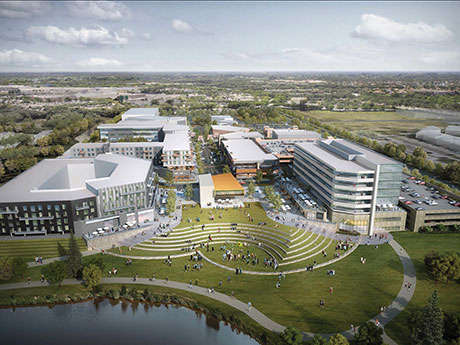By Holly Jones and Trey MacKnight, Cushman & Wakefield/The Lund Co.
The world of retail real estate in the Midwest has been rapidly evolving over the past few years, with the pandemic serving as a catalyst for more change. As we move further into 2023, it’s becoming increasingly clear that the retail landscape is different than in years past, yet healthy in numbers.
In this article, we’ll explore and explain some of the latest trends, developments, absorption and vacancy, and how this is impacting the industry as a whole. Whether you’re a retailer, landlord or investor, it’s essential to stay up to date with the current market and future developments.

Omaha’s retail market recorded 350,931 square feet of positive absorption in the fourth quarter, bringing the year-to-date absorption total to 1 million square feet. Throughout 2022, there were 34 buildings delivered, increasing the retail inventory by 379,733 square feet. At the close of the year, more than 86 percent of the new construction was occupied, creating a very healthy environment.
While there were sizable deals inked throughout the year, just over 85 percent of the new leases signed were under 5,000 square feet. Many of the leases were signed by non-traditional retail tenants such as gyms, medical offices and health & wellness-type tenants. Overall vacancy declined by 130 basis points year-over-year, ending the year at 4.6 percent. This is the lowest vacancy rate the market has seen since 2015, when it was 4.7 percent. This is impressive during a time where the pandemic strained most business.
Over the last few years, retail vacancy has been on a steady decline due to property conversions and redevelopments. Though many of these properties still contain a retail component, most of them are updated to include additional uses such as adding upper-level apartments or office space. The largest single occupier for the fourth quarter was Floor & Décor, taking 79,208 square feet of newly delivered space in the Central Omaha submarket.

Retail vacancy continues to trend downward, which is slowly pushing asking rents upward. At the close of 2022, local asking rents were reported at $14.53 per square foot, increasing by 17 cents year-over-year. The Sarpy West submarket fetched the highest asking rents at $20.53 per square foot. Sarpy is the fastest-growing county in the state and has a flurry of new construction from all uses popping up. Retail space in the area is in high demand and tenants are willing to pay more rent for prime locations.
Omaha’s growth
Despite a slowing economy and tight labor market, Omaha continues to see job growth. There were 13,700 non-farm payroll positions added year-over-year at the close of 2022. During the same time frame, the local unemployment rate decreased by 10 basis points, resting at 2.7 percent at the end of the fourth quarter. Omaha’s jobless rate is still one of the lowest in the nation and is 100 basis points below the national average of 3.7 percent.
Omaha’s median household income increased by $3,300 throughout 2022, compared with the national average increase of $2,800. Despite the wage increases, inflation has most Americans feeling a financial pinch, as the cost of living increased in nearly every aspect.
As inflation continues to rise, consumers have started tightening the reins on spending, as they’ve had to devote more of their budget to necessities such as groceries, rent and energy. While some economists are predicting a recession in 2023, others only expect a slowdown and predict inflation will ease.
Development activity
La Vista City Centre, a new mixed-use development located in Sarpy County, is near completion and thriving. A development consisting of mutifamily, an outdoor entertainment venue called The Astro, traditional retail and office, La Vista City Centre is a great example of a project in Omaha keeping retail strong. The project is driving patrons to the Centre and assisting to reinvent the neighborhood as a whole. Projects like this continue to be constructed throughout the city providing jobs and opportunity.
NoDo (North Downtown) neighborhoods are booming with new ground-up developments and redevelopments of historic buildings. This has provided new and creative energy to the most recently stagnant downtown retail market.
These neighborhoods are located north of the central business district and nestled between prominent locations including CHI Arena, Charles Schwab Field and Creighton University. The development and redevelopment in this area has brought in hundreds of apartment units plus the relocation of Kiewit headquarters. To continue efforts for live-work-play, retail has remained an important factor to be included in NoDo projects. The retail options have attracted local, regional and national attention.
In conclusion, the future of retail real estate is looking bright, but it’s also very different from what we’ve known in the past. The pandemic has accelerated many of the changes that were already underway, and it’s clear that retailers, landlords and investors will need to adapt to stay ahead of the curve. The information shared within this article proves success is still doable.
It has always been important to provide good value, good customer service and create out-of-the-box experiences for shoppers but more so now than ever before. This has not changed for retail nationally and certainly not in Omaha.
It’s important in real estate today to be willing to take risks and embrace change. It’s an exciting time for retail real estate and there is definitely a positive future in store based on low unemployment and low vacancy. Creative retail projects will provide unique experiences for consumers that will continue to provide success in today’s real estate market.
Holly Jones is director of retail services and Trey MacKnight is an associate with Cushman & Wakefield/The Lund Co. This article originally appeared in the April 2023 issue of Heartland Real Estate Business magazine.


